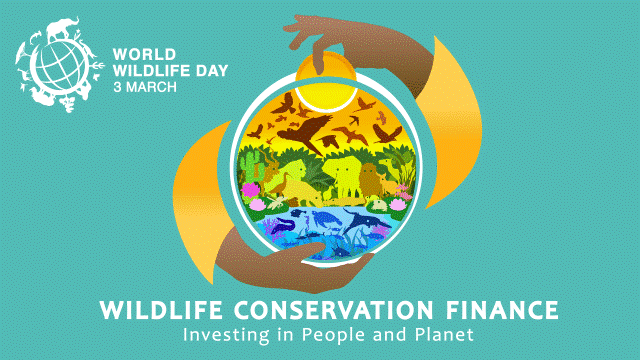World Wildlife Day 2025

- 05 Mar 2025
In News:
World Wildlife Day is observed on March 3 every year, and in 2025, it will be observed under the theme of “Wildlife Conservation Finance: Investing in People and Planet.”
Key Details:
- Declared by: United Nations General Assembly (UNGA)
- First Observed: 2014
- Occasion: Commemorates the signing of CITES (Convention on International Trade in Endangered Species of Wild Fauna and Flora) in 1973.
- Theme 2025:“Wildlife Conservation Finance: Investing in People and Planet”
Purpose and Significance
World Wildlife Day is an annual UN-recognized global event aimed at:
- Raising awareness about wild fauna and flora.
- Highlighting threats such as climate change, poaching, habitat destruction, and illegal wildlife trade.
- Encouraging global cooperation for wildlife protection.
- Promoting innovative financing models to bridge the estimated $824 billion global biodiversity funding gap.
2025 Theme Focus: Conservation Finance
The 2025 theme calls for sustainable financial strategies, emphasizing:
- Wildlife Conservation Bonds
- Debt-for-Nature Swaps
- Green Bonds and Carbon Credits
- Payments for Ecosystem Services (PES)
- Public-Private Partnerships
These mechanisms aim to support conservation while fostering economic opportunities for local communities.
Timeline of Key Events
- 1973: CITES adopted.
- 2013: UNGA designates March 3 as World Wildlife Day.
- 2014: First official celebration.
- 2021: Theme – Forests and Livelihoods.
- 2025: Theme – Finance for Conservation.
Wildlife Status in India
- Protected Areas: 1,014 total (as of 2024), including:
- 106 National Parks
- 573 Wildlife Sanctuaries
- 115 Conservation Reserves
- 220 Community Reserves
(Covers ~5.32% of India’s total area)
- Tiger Population (2022): 3,682 – ~75% of global wild tigers
- Asiatic Lion Population (2020): ~674 (only in Gujarat's Gir Forest)
- India's Biodiversity Share:
- 7.6% of global mammal species
- 14.7% of amphibians
- 6% of birds and reptiles
- 6% of flowering plants
Major Causes of Wildlife Decline
- Habitat loss & fragmentation
- Illegal wildlife trade and poaching
- Climate change and pollution
- Invasive species
- Industrialization & urban expansion
Conservation Measures in India
- Project Tiger (1973): Boosted tiger numbers significantly.
- Project Elephant (1992): Focuses on elephant corridors and human-wildlife conflict mitigation.
- Wildlife Protection Act (1972): Key legal framework to safeguard endangered species.
- Eco-Sensitive Zones (ESZs): Buffer areas around protected habitats.
- Community Initiatives: Ecotourism, local participation in conservation.
